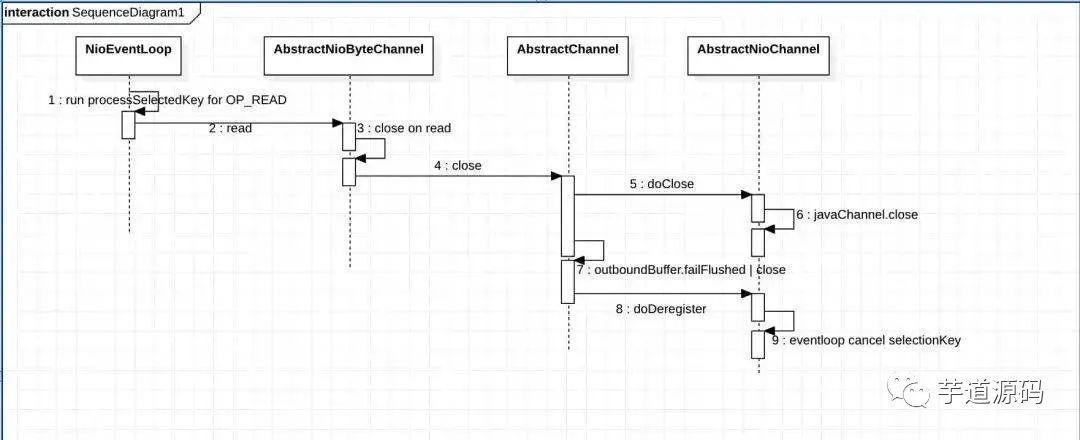一文了解 Netty 整体流程
Posted 芋道源码
tags:
篇首语:本文由小常识网(cha138.com)小编为大家整理,主要介绍了一文了解 Netty 整体流程相关的知识,希望对你有一定的参考价值。
管她前浪,还是后浪?
能浪的浪,才是好浪!
每天 8:55 更新文章,每天掉亿点点头发...
源码精品专栏
本文基于版本 4.1.46,同时只描述类而不展示具体源码。
Netty 的整体流程相对来说还是比较复杂的,初学者往往会被绕晕。所以这里总结了一下整体的流程,从而对 Netty 的整体服务流程有一个大致的了解。从功能上,流程可以分为服务启动、建立连接、读取数据、业务处理、发送数据、关闭连接以及关闭服务。整体流程如下所示(图中没有包含关闭的部分):
服务启动时,我们以 example 代码中的 EchoServer 为例,启动的过程以及相应的源码类如下:
-
EchoServer#new NioEventLoopGroup(1)->NioEventLoop#provider.openSelector(): 创建 selector -
EchoServer#b.bind(PORT).sync->AbstractBootStrap#doBind()->initAndRegister()-> channelFactory.newChannel() / init(channel): 创建 serverSocketChannel 以及初始化 -
EchoServer#b.bind(PORT).sync->AbstractBootStrap#doBind()->initAndRegister()-> config().group().register(channel):从 boss group 中选择一个 NioEventLoop 开始注册 serverSocketChannel -
EchoServer#b.bind(PORT).sync->AbstractBootStrap#doBind()->initAndRegister()->config().group().register(channel)->AbstractChannel#register0(promise)->AbstractNioChannel#javaChannel().register(eventLoop().unwrappedSelector(), 0, this): 将 server socket channel 注册到选择的 NioEventLoop 的 selector -
EchoServer#b.bind(PORT).sync()->AbstractBootStrap#doBind()->doBind0()->AbstractChannel#doBind(localAddress)->NioserverSocketChannel#javaChannel().bind(localAddress, config.getBacklog()): 绑定地址端口开始启动 -
EchoServer#b.bind(PORT).sync()->AbstractBootStrap#doBind()->doBind0()->AbstractChannel#pipeline.fireChannelActive()->AbstractNioChannel#selectionKey.interestOps(interestOps|readInterestOp): 注册 OP_READ 事件
上述启动流程中,1、2、3 是由我们自己的线程执行的,即 mainThread,4、5、6 是由 Boss Thread 执行。相应时序图如下:

服务启动后便是建立连接的过程了,相应过程及源码类如下:
-
NioEventLoop#run()->processSelectedKey()NioEventLoop 中的 selector 轮询创建连接事件(OP_ACCEPT) -
NioEventLoop#run()->processSelectedKey()->AbstractNioMessageChannel#read->NioServerSocketChannel#doReadMessages()->SocketUtil#accept(serverSocketChannel)创建 socket channel -
NioEventLoop#run()->processSelectedKey()->AbstractNioMessageChannel#fireChannelRead->ServerBootstrap#ServerBootstrapAcceptor#channelRead-> childGroup.register(child)从worker group 中选择一个 NioEventLoop 开始注册 socket channel -
NioEventLoop#run()->processSelectedKey()->AbstractNioMessageChannel#fireChannelRead->ServerBootstrap#ServerBootstrapAcceptor#channelRead-> childGroup.register(child)->AbstractChannel#register0(promise)-> AbstractNioChannel#javaChannel().register(eventLoop().unwrappedSelector(), 0, this)将 socket channel 注册到选择的 NioEventLoop 的 selector -
NioEventLoop#run()->processSelectedKey()->AbstractNioMessageChannel#fireChannelRead->ServerBootstrap#ServerBootstrapAcceptor#channelRead-> childGroup.register(child)->AbstractChannel#pipeline.fireChannelActive()-> AbstractNioChannel#selectionKey.interestOps(interestOps | readInterestOp)注册 OP_ACCEPT 事件
同样,上述流程中 1、2、3 的执行仍由 Boss Thread 执行,直到 4、5 由具体的 Work Thread 执行。
连接建立完毕后是具体的读写,以及业务处理逻辑。以 EchoServerHandler 为例,读取数据后会将数据传播出去供业务逻辑处理,此时的 EchoServerHandler 代表我们的业务逻辑,而它的实现也非常简单,就是直接将数据写回去。我们将这块看成一个整条,流程如下:
-
NioEventLoop#run()->processSelectedKey() NioEventLoop 中的 selector轮询创建读取事件(OP_READ) -
NioEventLoop#run()->processSelectedKey()->AbstractNioByteChannel#read()nioSocketChannel 开始读取数据 -
NioEventLoop#run()->processSelectedKey()->AbstractNioByteChannel#read()->pipeline.fireChannelRead(byteBuf)把读取到的数据传播出去供业务处理 -
AbstractNioByteChannel#pipeline.fireChannelRead->EchoServerHandler#channelRead在这个例子中即 EchoServerHandler 的执行 -
EchoServerHandler#write->ChannelOutboundBuffer#addMessage调用 write 方法 -
EchoServerHandler#flush->ChannelOutboundBuffer#addFlush调用 flush 准备数据 -
EchoServerHandler#flush->NioSocketChannel#doWrite调用 flush 发送数据
在这个过程中读写数据都是由 Work Thread 执行的,但是业务处理可以由我们自定义的线程池来处理,并且一般我们也是这么做的,默认没有指定线程的情况下仍然由 Work Thread 代为处理。
服务处理完毕后,单个连接的关闭是什么样的呢?
-
NioEventLoop#run()->processSelectedKey()NioEventLoop 中的 selector 轮询创建读取事件(OP_READ),这里关闭连接仍然是读取事件 -
NioEventLoop#run()->processSelectedKey()->AbstractNioByteChannel#read()->closeOnRead(pipeline)当字节<0 时开始执行关闭 nioSocketChannel -
NioEventLoop#run()->processSelectedKey()->AbstractNioByteChannel#read()->closeOnRead(pipeline)->AbstractChannel#close->AbstractNioChannel#doClose()关闭 socketChannel -
NioEventLoop#run()->processSelectedKey()->AbstractNioByteChannel#read()->closeOnRead(pipeline)->AbstractChannel#close->outboundBuffer.failFlushed/close清理消息:不接受新信息,fail 掉所有 queue 中消息 -
NioEventLoop#run()->processSelectedKey()->AbstractNioByteChannel#read()->closeOnRead(pipeline)->AbstractChannel#close->fireChannelInactiveAndDeregister->AbstractNioChannel#doDeregister eventLoop().cancel(selectionKey())关闭多路复用器的 key
时序图如下:

最后是关闭整个 Netty 服务:
-
NioEventLoop#run->closeAll()->selectionKey.cancel/channel.close关闭 channel,取消 selectionKey -
NioEventLoop#run->confirmShutdown->cancelScheduledTasks取消定时任务 -
NioEventLoop#cleanup->selector.close()关闭 selector
时序图如下,为了好画将 NioEventLoop 拆成了 2 块:
至此,整个 Netty 的服务流程就结束了。
- END -已在知识星球更新源码解析如下:
最近更新《芋道 SpringBoot 2.X 入门》系列,已经 20 余篇,覆盖了 MyBatis、Redis、MongoDB、ES、分库分表、读写分离、SpringMVC、Webflux、权限、WebSocket、Dubbo、RabbitMQ、RocketMQ、Kafka、性能测试等等内容。
提供近 3W 行代码的 SpringBoot 示例,以及超 4W 行代码的电商微服务项目。
文章有帮助的话,在看,转发吧。
谢谢支持哟 (*^__^*)
以上是关于一文了解 Netty 整体流程的主要内容,如果未能解决你的问题,请参考以下文章